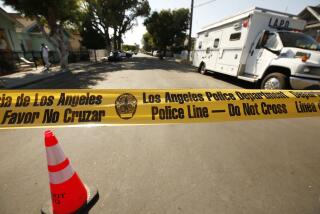Woman’s Role in Airline Extortion Attempt Disputed : Courts: Prosecution claims Joan Hill was an integral part of bomb threat. Defense says she was an unwitting accomplice who did not know the true nature of her act.
- Share via
The federal trial of a Hawthorne woman charged with planting a fake bomb on a United Airlines jetliner began Thursday with a prosecutor claiming the woman was an “integral part” of a friend’s plan to extort $600,000 from the airline.
But a defense lawyer for 42-year-old Joan Hill said that although the defendant planted a package on the plane in November before it left Los Angeles International Airport for New York, she did not know the true contents.
Hill was arrested after a letter titled “Bomb Threat” was faxed to United Airlines headquarters near Chicago while the plane was in flight. The letter warned that the plane would be blown up unless the airline paid $600,000 to Paul Stoos, 20, of Los Angeles. The U.S. attorney alleges that Stoos was the mastermind of the extortion plot.
Hill is charged with helping to deliver a threat that could have endangered the safety of an aircraft and caused harm to others. Stoos, who traveled under the alias Harry Connick Jr., is awaiting sentencing in federal court in Brooklyn after pleading guilty in February to extortion, Assistant U.S. Attorney Michael Terrell said.
An informant in Los Angeles lead agents to Stoos and Hill, whose case was transferred to Los Angeles because her witnesses live in the area.
The threat was passed on to the flight crew almost four hours into the flight. The crew discovered the package, which Stoos said was modeled after a phony bomb in the movie Lethal Weapon 2, in a luggage bin under some blankets.
Passengers were moved to the front of the plane and the co-pilot “carefully, very carefully” moved the package to the rear of the plane, Terrell said. After the plane landed safely at John F. Kennedy Airport in New York, investigators determined that the package was merely a cardboard box with wires that was made to resemble a bomb.
In opening arguments Thursday before a jury panel and Chief Judge Manuel L. Real of U.S. District Court in Los Angeles, Terrell labeled the scheme a “carefully planned attempt to use a bomb to have United Airlines pay $600,000.”
Stoos asked Hill, an employee of Northwest Airlines at LAX, to help him plant the package on the airplane.
According to federal investigators, Stoos, a former employee of several airlines, gave Hill a note containing security codes that would allow her access to the ramp that extends from the terminal to the aircraft.
Stoos also gave Hill a key to an airport locker containing the package. He told her to remove the package from the locker, place it on the airplane, and then call him in New York, where he would be on the morning of Nov. 11.
Hill followed the instructions, FBI agents said in their report, but she said Stoos had told her the package had something to do with a kidnaping ransom, not a bombing.
Although she realized that taking part in a kidnaping scheme would also have been wrong, she told the FBI that she participated anyway because she needed the $500 that Stoos promised for her help. Had she known the true purpose of the package, she would not have done it, she told Special Agent Dana Ingalls.
Nevertheless, Terrell said, “this is a straightforward case. Defendant Hill was an integral part of this bomb threat scheme.”
Defense Attorney David A. Katz, however, portrayed Hill as an unwitting accomplice in a “heinous” crime.
“There was no partnership in crime, as the prosecution insinuates,” Katz said.
Instead, Katz said, Stoos is to blame for the whole affair, since Hill never saw the bomb threat letter or was filled in on precisely what Stoos planned.
“She never saw this terrifying letter or had any idea of this terrifying letter,” Katz said. “The evidence will show she just went about putting a box on a plane to help a friend.”
Proof, he said, was Hill’s willingness to let FBI agents into her home without a warrant and to speak with them, even though she knew that news of the bomb hoax was receiving extensive television coverage.
After news of the hoax became public, Stoos later told Hill that he had not told her his true intent because she “would not have done it otherwise,” Katz asserted.
More to Read
Sign up for Essential California
The most important California stories and recommendations in your inbox every morning.
You may occasionally receive promotional content from the Los Angeles Times.












